The Extent of Crime as a Product of Individual Free Will
VerifiedAdded on 2023/04/19
|11
|3327
|350
Essay
AI Summary
This essay delves into the ongoing debate within criminology concerning the extent to which crime is a product of individual free will. The paper investigates the arguments both for and against the notion of free will in the context of criminal behavior. It examines various theories, including routine activity theory and socio-biological perspectives, exploring how factors beyond individual choice, such as socioeconomic conditions, genetic predispositions, and environmental influences, may contribute to criminal actions. The essay considers the interplay of these factors and the implications for understanding and addressing crime. The paper draws upon diverse sources, including academic studies, to offer a comprehensive overview of the topic.
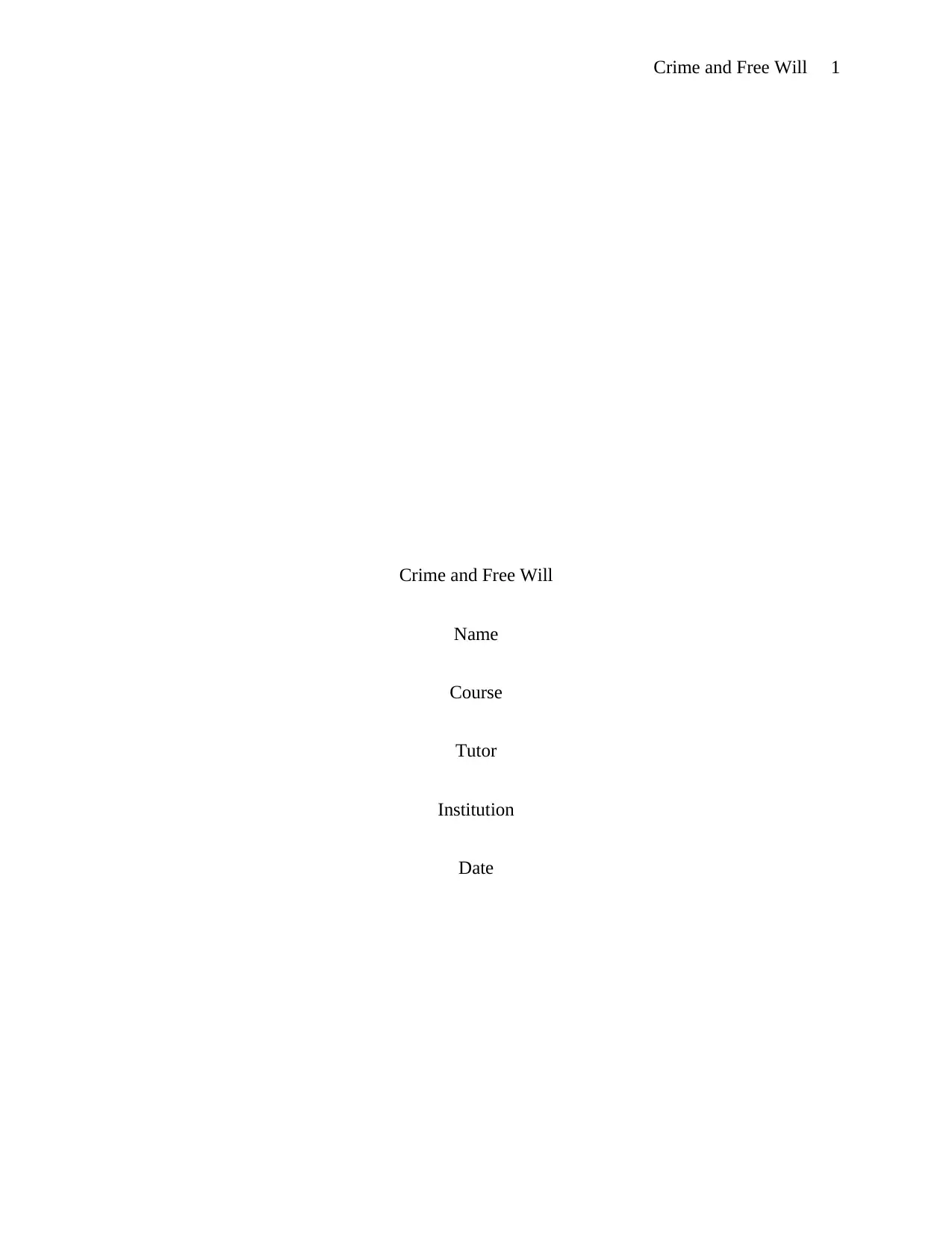
Crime and Free Will 1
Crime and Free Will
Name
Course
Tutor
Institution
Date
Crime and Free Will
Name
Course
Tutor
Institution
Date
Paraphrase This Document
Need a fresh take? Get an instant paraphrase of this document with our AI Paraphraser
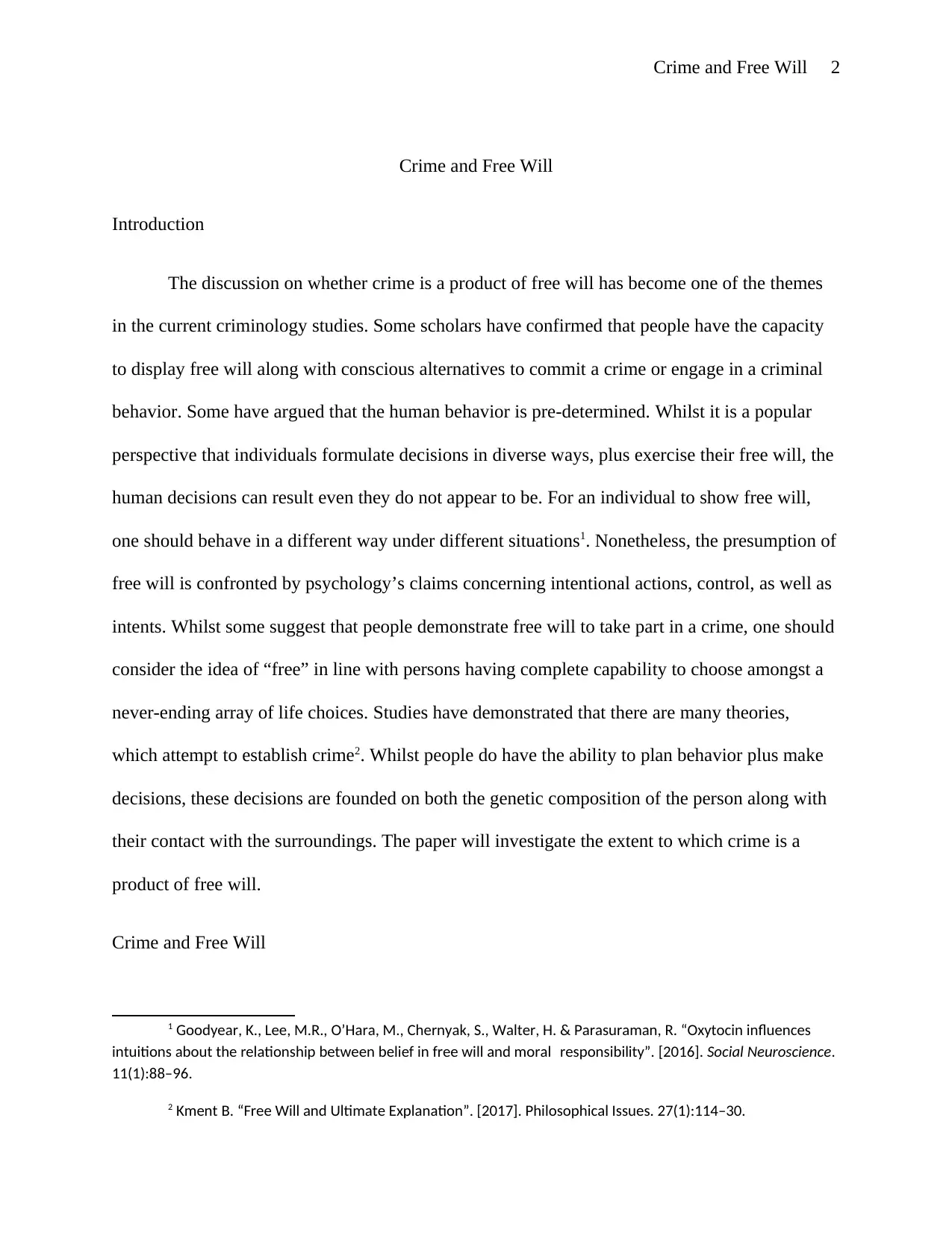
Crime and Free Will 2
Crime and Free Will
Introduction
The discussion on whether crime is a product of free will has become one of the themes
in the current criminology studies. Some scholars have confirmed that people have the capacity
to display free will along with conscious alternatives to commit a crime or engage in a criminal
behavior. Some have argued that the human behavior is pre-determined. Whilst it is a popular
perspective that individuals formulate decisions in diverse ways, plus exercise their free will, the
human decisions can result even they do not appear to be. For an individual to show free will,
one should behave in a different way under different situations1. Nonetheless, the presumption of
free will is confronted by psychology’s claims concerning intentional actions, control, as well as
intents. Whilst some suggest that people demonstrate free will to take part in a crime, one should
consider the idea of “free” in line with persons having complete capability to choose amongst a
never-ending array of life choices. Studies have demonstrated that there are many theories,
which attempt to establish crime2. Whilst people do have the ability to plan behavior plus make
decisions, these decisions are founded on both the genetic composition of the person along with
their contact with the surroundings. The paper will investigate the extent to which crime is a
product of free will.
Crime and Free Will
1 Goodyear, K., Lee, M.R., O’Hara, M., Chernyak, S., Walter, H. & Parasuraman, R. “Oxytocin influences
intuitions about the relationship between belief in free will and moral responsibility”. [2016]. Social Neuroscience.
11(1):88–96.
2 Kment B. “Free Will and Ultimate Explanation”. [2017]. Philosophical Issues. 27(1):114–30.
Crime and Free Will
Introduction
The discussion on whether crime is a product of free will has become one of the themes
in the current criminology studies. Some scholars have confirmed that people have the capacity
to display free will along with conscious alternatives to commit a crime or engage in a criminal
behavior. Some have argued that the human behavior is pre-determined. Whilst it is a popular
perspective that individuals formulate decisions in diverse ways, plus exercise their free will, the
human decisions can result even they do not appear to be. For an individual to show free will,
one should behave in a different way under different situations1. Nonetheless, the presumption of
free will is confronted by psychology’s claims concerning intentional actions, control, as well as
intents. Whilst some suggest that people demonstrate free will to take part in a crime, one should
consider the idea of “free” in line with persons having complete capability to choose amongst a
never-ending array of life choices. Studies have demonstrated that there are many theories,
which attempt to establish crime2. Whilst people do have the ability to plan behavior plus make
decisions, these decisions are founded on both the genetic composition of the person along with
their contact with the surroundings. The paper will investigate the extent to which crime is a
product of free will.
Crime and Free Will
1 Goodyear, K., Lee, M.R., O’Hara, M., Chernyak, S., Walter, H. & Parasuraman, R. “Oxytocin influences
intuitions about the relationship between belief in free will and moral responsibility”. [2016]. Social Neuroscience.
11(1):88–96.
2 Kment B. “Free Will and Ultimate Explanation”. [2017]. Philosophical Issues. 27(1):114–30.
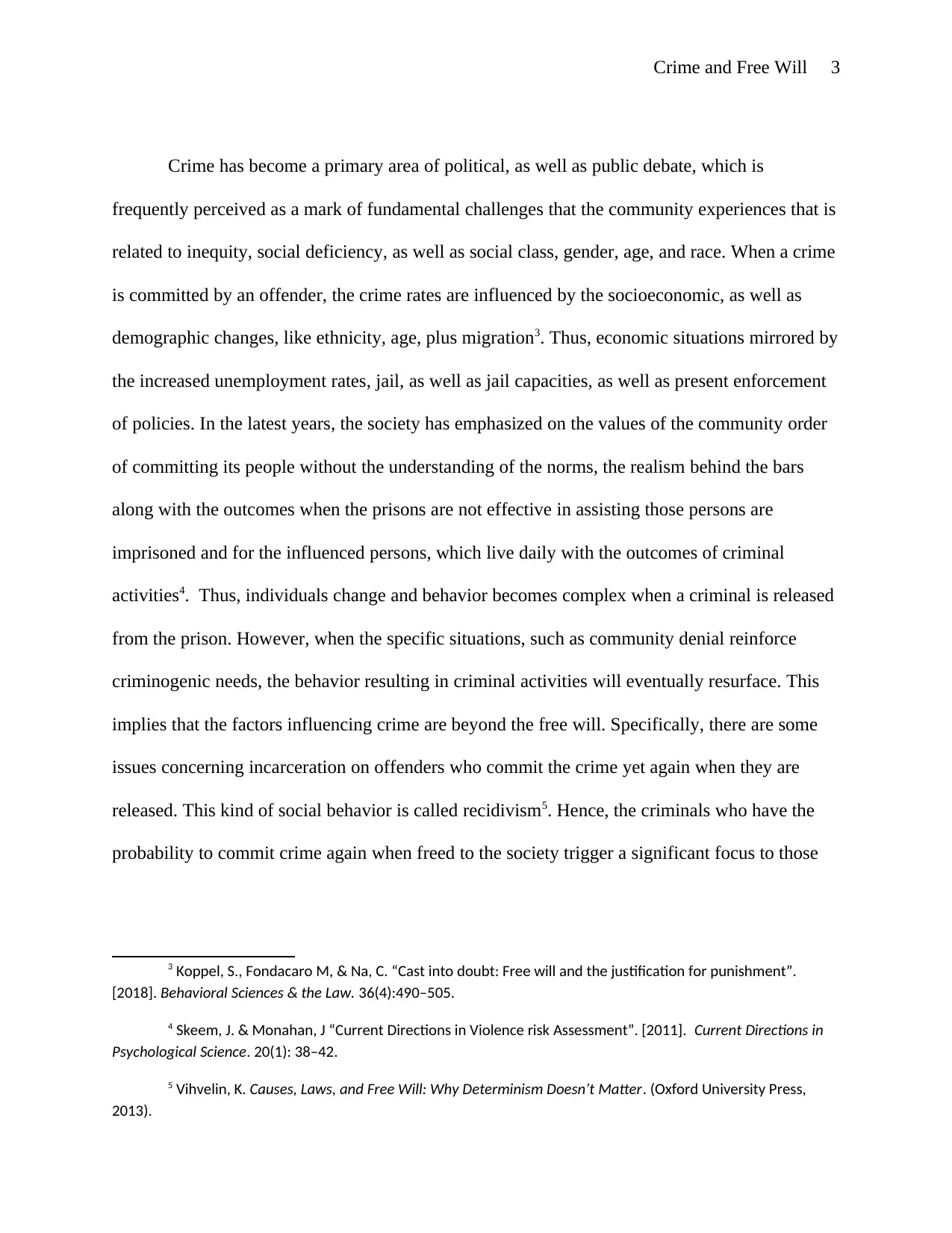
Crime and Free Will 3
Crime has become a primary area of political, as well as public debate, which is
frequently perceived as a mark of fundamental challenges that the community experiences that is
related to inequity, social deficiency, as well as social class, gender, age, and race. When a crime
is committed by an offender, the crime rates are influenced by the socioeconomic, as well as
demographic changes, like ethnicity, age, plus migration3. Thus, economic situations mirrored by
the increased unemployment rates, jail, as well as jail capacities, as well as present enforcement
of policies. In the latest years, the society has emphasized on the values of the community order
of committing its people without the understanding of the norms, the realism behind the bars
along with the outcomes when the prisons are not effective in assisting those persons are
imprisoned and for the influenced persons, which live daily with the outcomes of criminal
activities4. Thus, individuals change and behavior becomes complex when a criminal is released
from the prison. However, when the specific situations, such as community denial reinforce
criminogenic needs, the behavior resulting in criminal activities will eventually resurface. This
implies that the factors influencing crime are beyond the free will. Specifically, there are some
issues concerning incarceration on offenders who commit the crime yet again when they are
released. This kind of social behavior is called recidivism5. Hence, the criminals who have the
probability to commit crime again when freed to the society trigger a significant focus to those
3 Koppel, S., Fondacaro M, & Na, C. “Cast into doubt: Free will and the justification for punishment”.
[2018]. Behavioral Sciences & the Law. 36(4):490–505.
4 Skeem, J. & Monahan, J “Current Directions in Violence risk Assessment”. [2011]. Current Directions in
Psychological Science. 20(1): 38–42.
5 Vihvelin, K. Causes, Laws, and Free Will: Why Determinism Doesn’t Matter. (Oxford University Press,
2013).
Crime has become a primary area of political, as well as public debate, which is
frequently perceived as a mark of fundamental challenges that the community experiences that is
related to inequity, social deficiency, as well as social class, gender, age, and race. When a crime
is committed by an offender, the crime rates are influenced by the socioeconomic, as well as
demographic changes, like ethnicity, age, plus migration3. Thus, economic situations mirrored by
the increased unemployment rates, jail, as well as jail capacities, as well as present enforcement
of policies. In the latest years, the society has emphasized on the values of the community order
of committing its people without the understanding of the norms, the realism behind the bars
along with the outcomes when the prisons are not effective in assisting those persons are
imprisoned and for the influenced persons, which live daily with the outcomes of criminal
activities4. Thus, individuals change and behavior becomes complex when a criminal is released
from the prison. However, when the specific situations, such as community denial reinforce
criminogenic needs, the behavior resulting in criminal activities will eventually resurface. This
implies that the factors influencing crime are beyond the free will. Specifically, there are some
issues concerning incarceration on offenders who commit the crime yet again when they are
released. This kind of social behavior is called recidivism5. Hence, the criminals who have the
probability to commit crime again when freed to the society trigger a significant focus to those
3 Koppel, S., Fondacaro M, & Na, C. “Cast into doubt: Free will and the justification for punishment”.
[2018]. Behavioral Sciences & the Law. 36(4):490–505.
4 Skeem, J. & Monahan, J “Current Directions in Violence risk Assessment”. [2011]. Current Directions in
Psychological Science. 20(1): 38–42.
5 Vihvelin, K. Causes, Laws, and Free Will: Why Determinism Doesn’t Matter. (Oxford University Press,
2013).
⊘ This is a preview!⊘
Do you want full access?
Subscribe today to unlock all pages.

Trusted by 1+ million students worldwide

Crime and Free Will 4
worried about public wellbeing in handling the cost efficiency of putting the convicted criminal
in prison6.
Contrary to what the majority of individuals believe plus what judges claim that free will
in the well-built sense of metaphysical broadminded liberty is not a lawful criterion, which is
part of principle, and it is not even introductory for criminal liability. Criminal law principles are
completely dependable with the reality of determinism, which supposedly undermines the basis
of responsibility along with justice, which there is a reason to support7. The routine activity
theory proposes that a person will commit a crime provided the target is proper plus a competent
defender is not present. This implies that it is the assessment of situations that governs whether
an individual will commit a crime or not. Thus, a crime is often committed via a pretty chance, in
which a person may be exposed to an incentive for any specified period; the more of that
outcome would be connected to that person. A crime will be somehow unchanged by social
problems because wealth of the contemporary society provides enormous and encouraging
situations of prospects to commit criminal act, the persuasion are frequently appealing to
control8.
The influence of biological, as well as environmental elements on behavior of an
individual has been emphasize of much psychological study and theory that endeavors to identify
underlying pathways for a problem as complex9. Crimes are the product of consciously
6 Feldman, R. The Role of Science in Law. (New York: Oxford University Press, 2009).
7 Morson G. S. “The disease of theory: “Crime & Punishment” at 150”. [2016]. New Criterion..34(9):4–10.
8 Kment B.
9 Goodyear, K., Lee, M.R., O’Hara, M., Chernyak, S., Walter, H. & Parasuraman, R.
worried about public wellbeing in handling the cost efficiency of putting the convicted criminal
in prison6.
Contrary to what the majority of individuals believe plus what judges claim that free will
in the well-built sense of metaphysical broadminded liberty is not a lawful criterion, which is
part of principle, and it is not even introductory for criminal liability. Criminal law principles are
completely dependable with the reality of determinism, which supposedly undermines the basis
of responsibility along with justice, which there is a reason to support7. The routine activity
theory proposes that a person will commit a crime provided the target is proper plus a competent
defender is not present. This implies that it is the assessment of situations that governs whether
an individual will commit a crime or not. Thus, a crime is often committed via a pretty chance, in
which a person may be exposed to an incentive for any specified period; the more of that
outcome would be connected to that person. A crime will be somehow unchanged by social
problems because wealth of the contemporary society provides enormous and encouraging
situations of prospects to commit criminal act, the persuasion are frequently appealing to
control8.
The influence of biological, as well as environmental elements on behavior of an
individual has been emphasize of much psychological study and theory that endeavors to identify
underlying pathways for a problem as complex9. Crimes are the product of consciously
6 Feldman, R. The Role of Science in Law. (New York: Oxford University Press, 2009).
7 Morson G. S. “The disease of theory: “Crime & Punishment” at 150”. [2016]. New Criterion..34(9):4–10.
8 Kment B.
9 Goodyear, K., Lee, M.R., O’Hara, M., Chernyak, S., Walter, H. & Parasuraman, R.
Paraphrase This Document
Need a fresh take? Get an instant paraphrase of this document with our AI Paraphraser
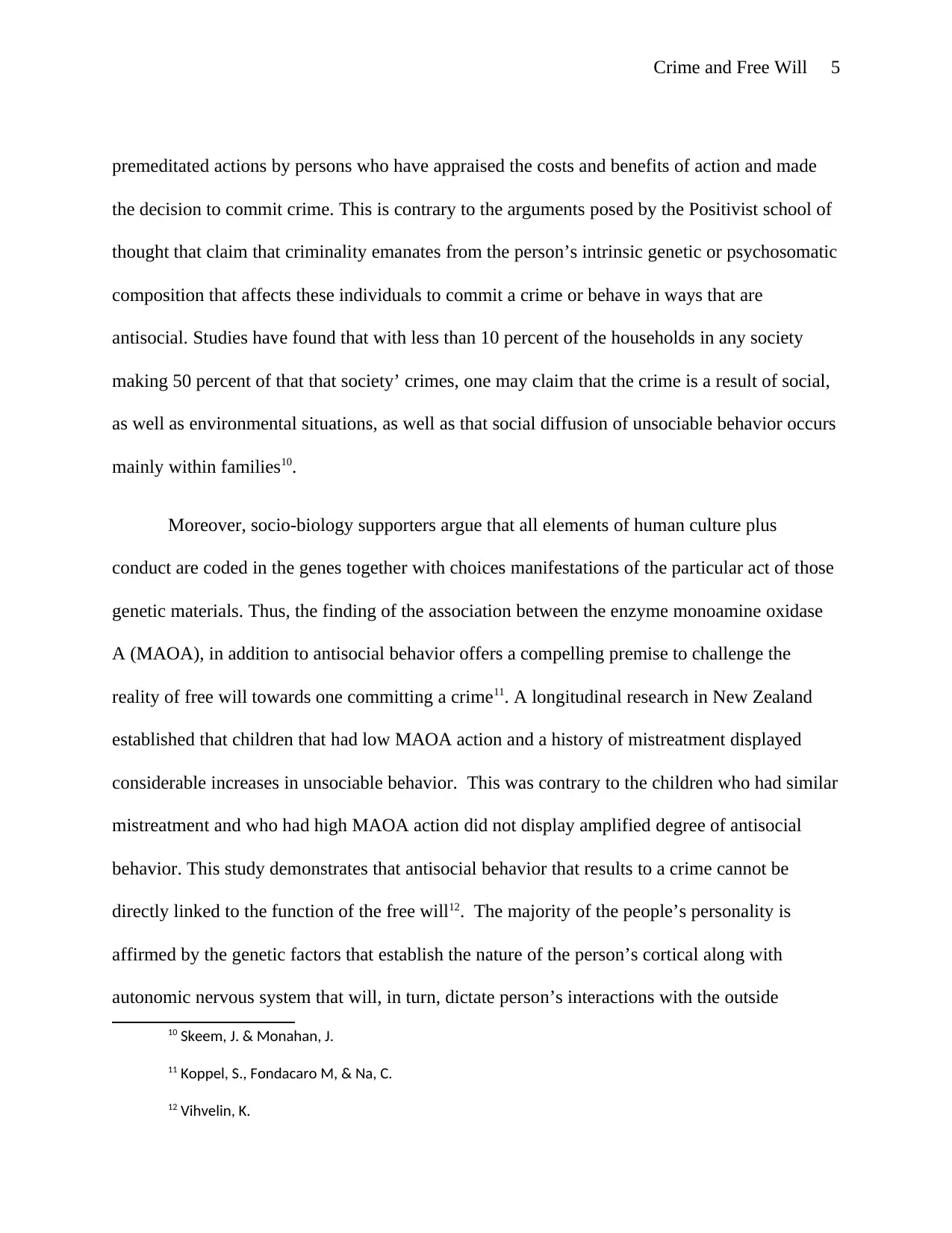
Crime and Free Will 5
premeditated actions by persons who have appraised the costs and benefits of action and made
the decision to commit crime. This is contrary to the arguments posed by the Positivist school of
thought that claim that criminality emanates from the person’s intrinsic genetic or psychosomatic
composition that affects these individuals to commit a crime or behave in ways that are
antisocial. Studies have found that with less than 10 percent of the households in any society
making 50 percent of that that society’ crimes, one may claim that the crime is a result of social,
as well as environmental situations, as well as that social diffusion of unsociable behavior occurs
mainly within families10.
Moreover, socio-biology supporters argue that all elements of human culture plus
conduct are coded in the genes together with choices manifestations of the particular act of those
genetic materials. Thus, the finding of the association between the enzyme monoamine oxidase
A (MAOA), in addition to antisocial behavior offers a compelling premise to challenge the
reality of free will towards one committing a crime11. A longitudinal research in New Zealand
established that children that had low MAOA action and a history of mistreatment displayed
considerable increases in unsociable behavior. This was contrary to the children who had similar
mistreatment and who had high MAOA action did not display amplified degree of antisocial
behavior. This study demonstrates that antisocial behavior that results to a crime cannot be
directly linked to the function of the free will12. The majority of the people’s personality is
affirmed by the genetic factors that establish the nature of the person’s cortical along with
autonomic nervous system that will, in turn, dictate person’s interactions with the outside
10 Skeem, J. & Monahan, J.
11 Koppel, S., Fondacaro M, & Na, C.
12 Vihvelin, K.
premeditated actions by persons who have appraised the costs and benefits of action and made
the decision to commit crime. This is contrary to the arguments posed by the Positivist school of
thought that claim that criminality emanates from the person’s intrinsic genetic or psychosomatic
composition that affects these individuals to commit a crime or behave in ways that are
antisocial. Studies have found that with less than 10 percent of the households in any society
making 50 percent of that that society’ crimes, one may claim that the crime is a result of social,
as well as environmental situations, as well as that social diffusion of unsociable behavior occurs
mainly within families10.
Moreover, socio-biology supporters argue that all elements of human culture plus
conduct are coded in the genes together with choices manifestations of the particular act of those
genetic materials. Thus, the finding of the association between the enzyme monoamine oxidase
A (MAOA), in addition to antisocial behavior offers a compelling premise to challenge the
reality of free will towards one committing a crime11. A longitudinal research in New Zealand
established that children that had low MAOA action and a history of mistreatment displayed
considerable increases in unsociable behavior. This was contrary to the children who had similar
mistreatment and who had high MAOA action did not display amplified degree of antisocial
behavior. This study demonstrates that antisocial behavior that results to a crime cannot be
directly linked to the function of the free will12. The majority of the people’s personality is
affirmed by the genetic factors that establish the nature of the person’s cortical along with
autonomic nervous system that will, in turn, dictate person’s interactions with the outside
10 Skeem, J. & Monahan, J.
11 Koppel, S., Fondacaro M, & Na, C.
12 Vihvelin, K.
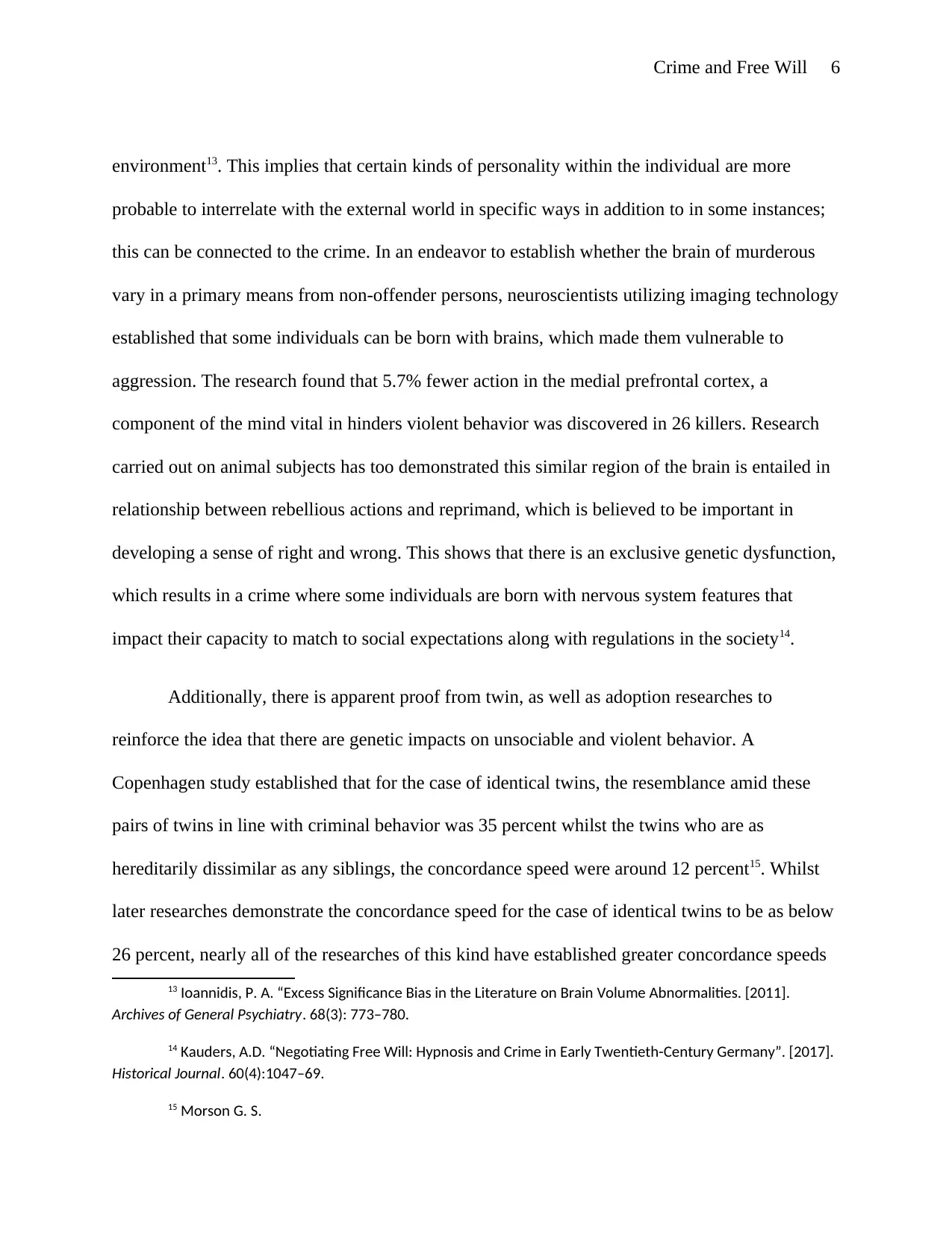
Crime and Free Will 6
environment13. This implies that certain kinds of personality within the individual are more
probable to interrelate with the external world in specific ways in addition to in some instances;
this can be connected to the crime. In an endeavor to establish whether the brain of murderous
vary in a primary means from non-offender persons, neuroscientists utilizing imaging technology
established that some individuals can be born with brains, which made them vulnerable to
aggression. The research found that 5.7% fewer action in the medial prefrontal cortex, a
component of the mind vital in hinders violent behavior was discovered in 26 killers. Research
carried out on animal subjects has too demonstrated this similar region of the brain is entailed in
relationship between rebellious actions and reprimand, which is believed to be important in
developing a sense of right and wrong. This shows that there is an exclusive genetic dysfunction,
which results in a crime where some individuals are born with nervous system features that
impact their capacity to match to social expectations along with regulations in the society14.
Additionally, there is apparent proof from twin, as well as adoption researches to
reinforce the idea that there are genetic impacts on unsociable and violent behavior. A
Copenhagen study established that for the case of identical twins, the resemblance amid these
pairs of twins in line with criminal behavior was 35 percent whilst the twins who are as
hereditarily dissimilar as any siblings, the concordance speed were around 12 percent15. Whilst
later researches demonstrate the concordance speed for the case of identical twins to be as below
26 percent, nearly all of the researches of this kind have established greater concordance speeds
13 Ioannidis, P. A. “Excess Significance Bias in the Literature on Brain Volume Abnormalities. [2011].
Archives of General Psychiatry. 68(3): 773–780.
14 Kauders, A.D. “Negotiating Free Will: Hypnosis and Crime in Early Twentieth-Century Germany”. [2017].
Historical Journal. 60(4):1047–69.
15 Morson G. S.
environment13. This implies that certain kinds of personality within the individual are more
probable to interrelate with the external world in specific ways in addition to in some instances;
this can be connected to the crime. In an endeavor to establish whether the brain of murderous
vary in a primary means from non-offender persons, neuroscientists utilizing imaging technology
established that some individuals can be born with brains, which made them vulnerable to
aggression. The research found that 5.7% fewer action in the medial prefrontal cortex, a
component of the mind vital in hinders violent behavior was discovered in 26 killers. Research
carried out on animal subjects has too demonstrated this similar region of the brain is entailed in
relationship between rebellious actions and reprimand, which is believed to be important in
developing a sense of right and wrong. This shows that there is an exclusive genetic dysfunction,
which results in a crime where some individuals are born with nervous system features that
impact their capacity to match to social expectations along with regulations in the society14.
Additionally, there is apparent proof from twin, as well as adoption researches to
reinforce the idea that there are genetic impacts on unsociable and violent behavior. A
Copenhagen study established that for the case of identical twins, the resemblance amid these
pairs of twins in line with criminal behavior was 35 percent whilst the twins who are as
hereditarily dissimilar as any siblings, the concordance speed were around 12 percent15. Whilst
later researches demonstrate the concordance speed for the case of identical twins to be as below
26 percent, nearly all of the researches of this kind have established greater concordance speeds
13 Ioannidis, P. A. “Excess Significance Bias in the Literature on Brain Volume Abnormalities. [2011].
Archives of General Psychiatry. 68(3): 773–780.
14 Kauders, A.D. “Negotiating Free Will: Hypnosis and Crime in Early Twentieth-Century Germany”. [2017].
Historical Journal. 60(4):1047–69.
15 Morson G. S.
⊘ This is a preview!⊘
Do you want full access?
Subscribe today to unlock all pages.

Trusted by 1+ million students worldwide
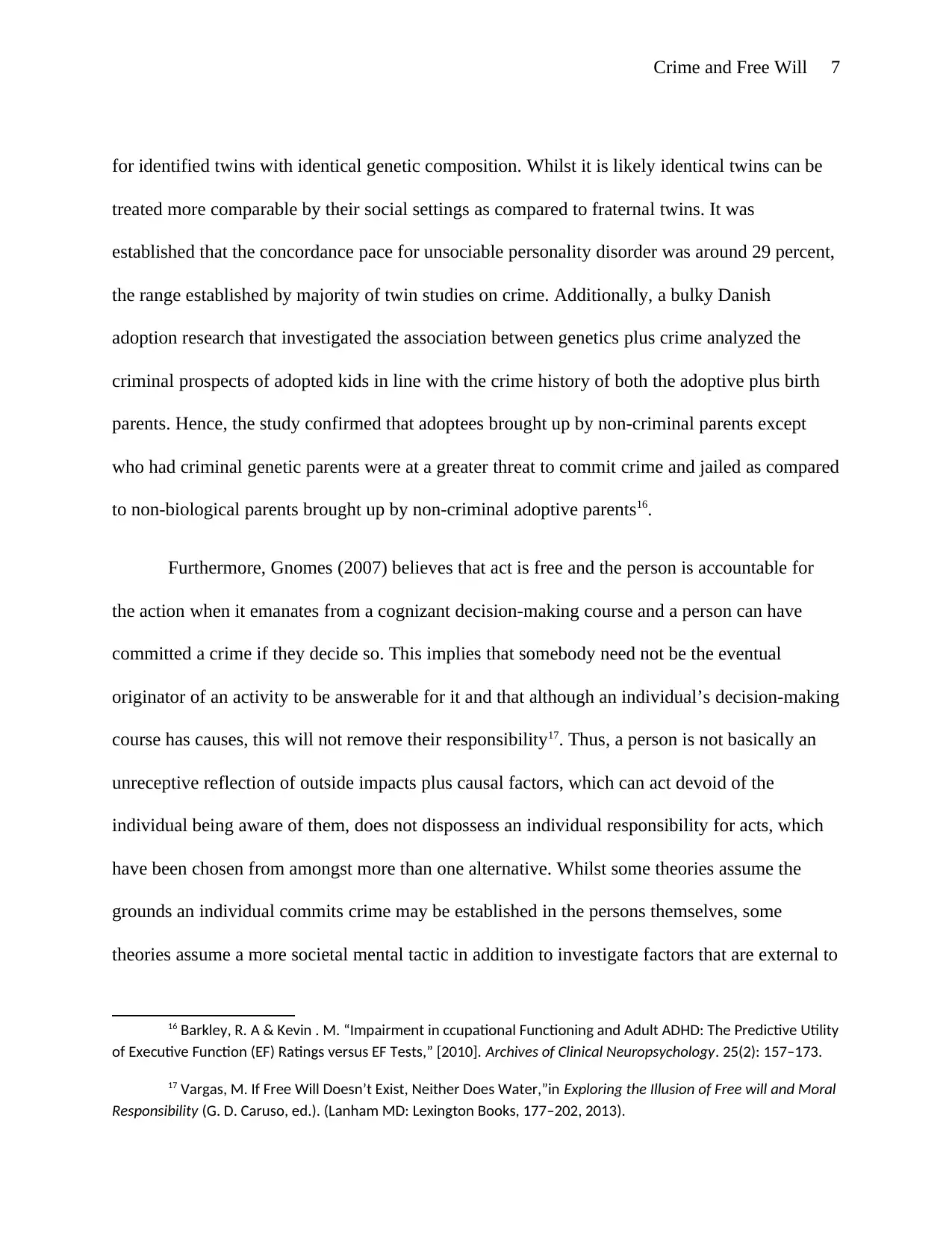
Crime and Free Will 7
for identified twins with identical genetic composition. Whilst it is likely identical twins can be
treated more comparable by their social settings as compared to fraternal twins. It was
established that the concordance pace for unsociable personality disorder was around 29 percent,
the range established by majority of twin studies on crime. Additionally, a bulky Danish
adoption research that investigated the association between genetics plus crime analyzed the
criminal prospects of adopted kids in line with the crime history of both the adoptive plus birth
parents. Hence, the study confirmed that adoptees brought up by non-criminal parents except
who had criminal genetic parents were at a greater threat to commit crime and jailed as compared
to non-biological parents brought up by non-criminal adoptive parents16.
Furthermore, Gnomes (2007) believes that act is free and the person is accountable for
the action when it emanates from a cognizant decision-making course and a person can have
committed a crime if they decide so. This implies that somebody need not be the eventual
originator of an activity to be answerable for it and that although an individual’s decision-making
course has causes, this will not remove their responsibility17. Thus, a person is not basically an
unreceptive reflection of outside impacts plus causal factors, which can act devoid of the
individual being aware of them, does not dispossess an individual responsibility for acts, which
have been chosen from amongst more than one alternative. Whilst some theories assume the
grounds an individual commits crime may be established in the persons themselves, some
theories assume a more societal mental tactic in addition to investigate factors that are external to
16 Barkley, R. A & Kevin . M. “Impairment in ccupational Functioning and Adult ADHD: The Predictive Utility
of Executive Function (EF) Ratings versus EF Tests,” [2010]. Archives of Clinical Neuropsychology. 25(2): 157–173.
17 Vargas, M. If Free Will Doesn’t Exist, Neither Does Water,”in Exploring the Illusion of Free will and Moral
Responsibility (G. D. Caruso, ed.). (Lanham MD: Lexington Books, 177–202, 2013).
for identified twins with identical genetic composition. Whilst it is likely identical twins can be
treated more comparable by their social settings as compared to fraternal twins. It was
established that the concordance pace for unsociable personality disorder was around 29 percent,
the range established by majority of twin studies on crime. Additionally, a bulky Danish
adoption research that investigated the association between genetics plus crime analyzed the
criminal prospects of adopted kids in line with the crime history of both the adoptive plus birth
parents. Hence, the study confirmed that adoptees brought up by non-criminal parents except
who had criminal genetic parents were at a greater threat to commit crime and jailed as compared
to non-biological parents brought up by non-criminal adoptive parents16.
Furthermore, Gnomes (2007) believes that act is free and the person is accountable for
the action when it emanates from a cognizant decision-making course and a person can have
committed a crime if they decide so. This implies that somebody need not be the eventual
originator of an activity to be answerable for it and that although an individual’s decision-making
course has causes, this will not remove their responsibility17. Thus, a person is not basically an
unreceptive reflection of outside impacts plus causal factors, which can act devoid of the
individual being aware of them, does not dispossess an individual responsibility for acts, which
have been chosen from amongst more than one alternative. Whilst some theories assume the
grounds an individual commits crime may be established in the persons themselves, some
theories assume a more societal mental tactic in addition to investigate factors that are external to
16 Barkley, R. A & Kevin . M. “Impairment in ccupational Functioning and Adult ADHD: The Predictive Utility
of Executive Function (EF) Ratings versus EF Tests,” [2010]. Archives of Clinical Neuropsychology. 25(2): 157–173.
17 Vargas, M. If Free Will Doesn’t Exist, Neither Does Water,”in Exploring the Illusion of Free will and Moral
Responsibility (G. D. Caruso, ed.). (Lanham MD: Lexington Books, 177–202, 2013).
Paraphrase This Document
Need a fresh take? Get an instant paraphrase of this document with our AI Paraphraser
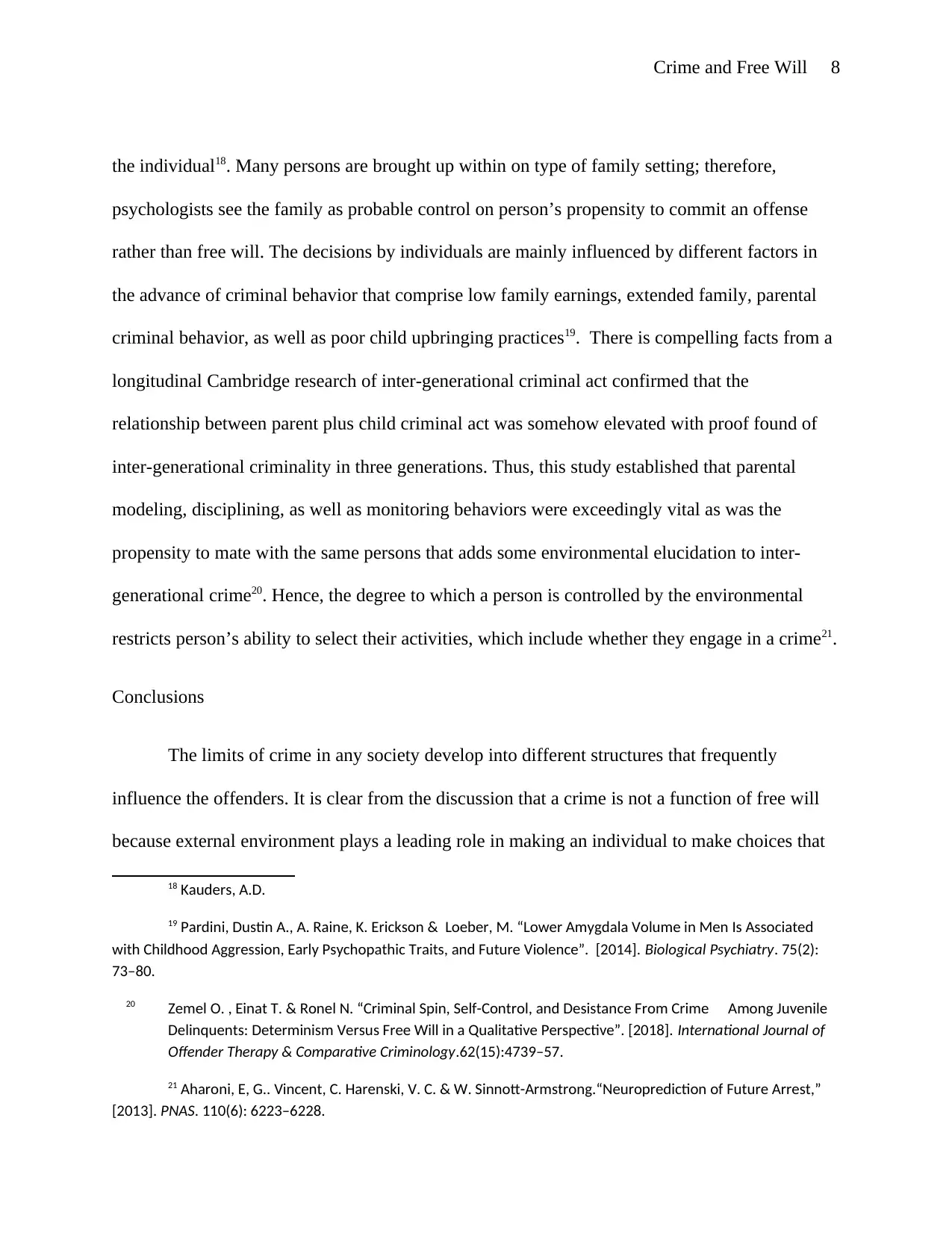
Crime and Free Will 8
the individual18. Many persons are brought up within on type of family setting; therefore,
psychologists see the family as probable control on person’s propensity to commit an offense
rather than free will. The decisions by individuals are mainly influenced by different factors in
the advance of criminal behavior that comprise low family earnings, extended family, parental
criminal behavior, as well as poor child upbringing practices19. There is compelling facts from a
longitudinal Cambridge research of inter-generational criminal act confirmed that the
relationship between parent plus child criminal act was somehow elevated with proof found of
inter-generational criminality in three generations. Thus, this study established that parental
modeling, disciplining, as well as monitoring behaviors were exceedingly vital as was the
propensity to mate with the same persons that adds some environmental elucidation to inter-
generational crime20. Hence, the degree to which a person is controlled by the environmental
restricts person’s ability to select their activities, which include whether they engage in a crime21.
Conclusions
The limits of crime in any society develop into different structures that frequently
influence the offenders. It is clear from the discussion that a crime is not a function of free will
because external environment plays a leading role in making an individual to make choices that
18 Kauders, A.D.
19 Pardini, Dustin A., A. Raine, K. Erickson & Loeber, M. “Lower Amygdala Volume in Men Is Associated
with Childhood Aggression, Early Psychopathic Traits, and Future Violence”. [2014]. Biological Psychiatry. 75(2):
73–80.
20 Zemel O. , Einat T. & Ronel N. “Criminal Spin, Self-Control, and Desistance From Crime Among Juvenile
Delinquents: Determinism Versus Free Will in a Qualitative Perspective”. [2018]. International Journal of
Offender Therapy & Comparative Criminology.62(15):4739–57.
21 Aharoni, E, G.. Vincent, C. Harenski, V. C. & W. Sinnott-Armstrong.“Neuroprediction of Future Arrest,”
[2013]. PNAS. 110(6): 6223–6228.
the individual18. Many persons are brought up within on type of family setting; therefore,
psychologists see the family as probable control on person’s propensity to commit an offense
rather than free will. The decisions by individuals are mainly influenced by different factors in
the advance of criminal behavior that comprise low family earnings, extended family, parental
criminal behavior, as well as poor child upbringing practices19. There is compelling facts from a
longitudinal Cambridge research of inter-generational criminal act confirmed that the
relationship between parent plus child criminal act was somehow elevated with proof found of
inter-generational criminality in three generations. Thus, this study established that parental
modeling, disciplining, as well as monitoring behaviors were exceedingly vital as was the
propensity to mate with the same persons that adds some environmental elucidation to inter-
generational crime20. Hence, the degree to which a person is controlled by the environmental
restricts person’s ability to select their activities, which include whether they engage in a crime21.
Conclusions
The limits of crime in any society develop into different structures that frequently
influence the offenders. It is clear from the discussion that a crime is not a function of free will
because external environment plays a leading role in making an individual to make choices that
18 Kauders, A.D.
19 Pardini, Dustin A., A. Raine, K. Erickson & Loeber, M. “Lower Amygdala Volume in Men Is Associated
with Childhood Aggression, Early Psychopathic Traits, and Future Violence”. [2014]. Biological Psychiatry. 75(2):
73–80.
20 Zemel O. , Einat T. & Ronel N. “Criminal Spin, Self-Control, and Desistance From Crime Among Juvenile
Delinquents: Determinism Versus Free Will in a Qualitative Perspective”. [2018]. International Journal of
Offender Therapy & Comparative Criminology.62(15):4739–57.
21 Aharoni, E, G.. Vincent, C. Harenski, V. C. & W. Sinnott-Armstrong.“Neuroprediction of Future Arrest,”
[2013]. PNAS. 110(6): 6223–6228.
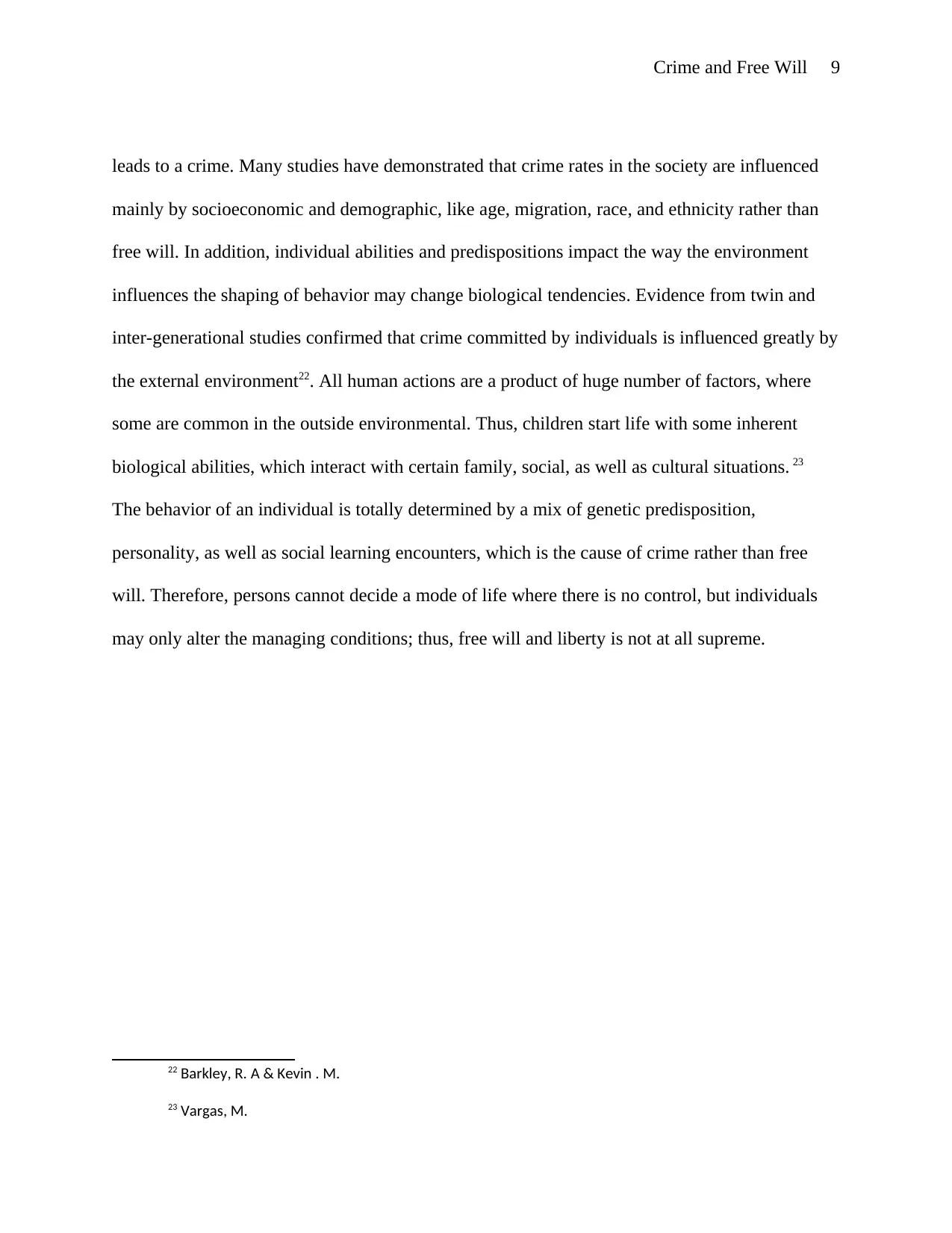
Crime and Free Will 9
leads to a crime. Many studies have demonstrated that crime rates in the society are influenced
mainly by socioeconomic and demographic, like age, migration, race, and ethnicity rather than
free will. In addition, individual abilities and predispositions impact the way the environment
influences the shaping of behavior may change biological tendencies. Evidence from twin and
inter-generational studies confirmed that crime committed by individuals is influenced greatly by
the external environment22. All human actions are a product of huge number of factors, where
some are common in the outside environmental. Thus, children start life with some inherent
biological abilities, which interact with certain family, social, as well as cultural situations. 23
The behavior of an individual is totally determined by a mix of genetic predisposition,
personality, as well as social learning encounters, which is the cause of crime rather than free
will. Therefore, persons cannot decide a mode of life where there is no control, but individuals
may only alter the managing conditions; thus, free will and liberty is not at all supreme.
22 Barkley, R. A & Kevin . M.
23 Vargas, M.
leads to a crime. Many studies have demonstrated that crime rates in the society are influenced
mainly by socioeconomic and demographic, like age, migration, race, and ethnicity rather than
free will. In addition, individual abilities and predispositions impact the way the environment
influences the shaping of behavior may change biological tendencies. Evidence from twin and
inter-generational studies confirmed that crime committed by individuals is influenced greatly by
the external environment22. All human actions are a product of huge number of factors, where
some are common in the outside environmental. Thus, children start life with some inherent
biological abilities, which interact with certain family, social, as well as cultural situations. 23
The behavior of an individual is totally determined by a mix of genetic predisposition,
personality, as well as social learning encounters, which is the cause of crime rather than free
will. Therefore, persons cannot decide a mode of life where there is no control, but individuals
may only alter the managing conditions; thus, free will and liberty is not at all supreme.
22 Barkley, R. A & Kevin . M.
23 Vargas, M.
⊘ This is a preview!⊘
Do you want full access?
Subscribe today to unlock all pages.

Trusted by 1+ million students worldwide
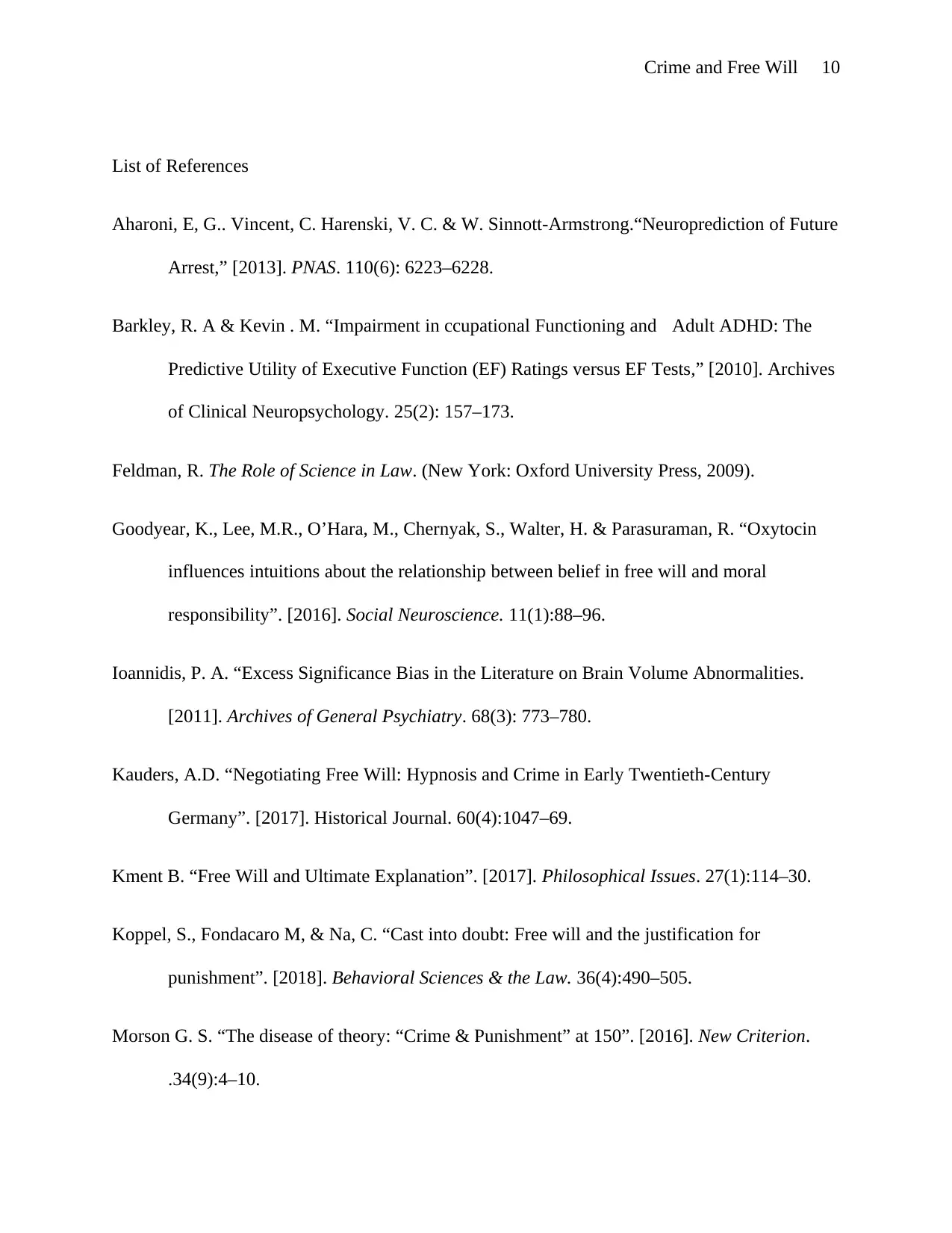
Crime and Free Will 10
List of References
Aharoni, E, G.. Vincent, C. Harenski, V. C. & W. Sinnott-Armstrong.“Neuroprediction of Future
Arrest,” [2013]. PNAS. 110(6): 6223–6228.
Barkley, R. A & Kevin . M. “Impairment in ccupational Functioning and Adult ADHD: The
Predictive Utility of Executive Function (EF) Ratings versus EF Tests,” [2010]. Archives
of Clinical Neuropsychology. 25(2): 157–173.
Feldman, R. The Role of Science in Law. (New York: Oxford University Press, 2009).
Goodyear, K., Lee, M.R., O’Hara, M., Chernyak, S., Walter, H. & Parasuraman, R. “Oxytocin
influences intuitions about the relationship between belief in free will and moral
responsibility”. [2016]. Social Neuroscience. 11(1):88–96.
Ioannidis, P. A. “Excess Significance Bias in the Literature on Brain Volume Abnormalities.
[2011]. Archives of General Psychiatry. 68(3): 773–780.
Kauders, A.D. “Negotiating Free Will: Hypnosis and Crime in Early Twentieth-Century
Germany”. [2017]. Historical Journal. 60(4):1047–69.
Kment B. “Free Will and Ultimate Explanation”. [2017]. Philosophical Issues. 27(1):114–30.
Koppel, S., Fondacaro M, & Na, C. “Cast into doubt: Free will and the justification for
punishment”. [2018]. Behavioral Sciences & the Law. 36(4):490–505.
Morson G. S. “The disease of theory: “Crime & Punishment” at 150”. [2016]. New Criterion.
.34(9):4–10.
List of References
Aharoni, E, G.. Vincent, C. Harenski, V. C. & W. Sinnott-Armstrong.“Neuroprediction of Future
Arrest,” [2013]. PNAS. 110(6): 6223–6228.
Barkley, R. A & Kevin . M. “Impairment in ccupational Functioning and Adult ADHD: The
Predictive Utility of Executive Function (EF) Ratings versus EF Tests,” [2010]. Archives
of Clinical Neuropsychology. 25(2): 157–173.
Feldman, R. The Role of Science in Law. (New York: Oxford University Press, 2009).
Goodyear, K., Lee, M.R., O’Hara, M., Chernyak, S., Walter, H. & Parasuraman, R. “Oxytocin
influences intuitions about the relationship between belief in free will and moral
responsibility”. [2016]. Social Neuroscience. 11(1):88–96.
Ioannidis, P. A. “Excess Significance Bias in the Literature on Brain Volume Abnormalities.
[2011]. Archives of General Psychiatry. 68(3): 773–780.
Kauders, A.D. “Negotiating Free Will: Hypnosis and Crime in Early Twentieth-Century
Germany”. [2017]. Historical Journal. 60(4):1047–69.
Kment B. “Free Will and Ultimate Explanation”. [2017]. Philosophical Issues. 27(1):114–30.
Koppel, S., Fondacaro M, & Na, C. “Cast into doubt: Free will and the justification for
punishment”. [2018]. Behavioral Sciences & the Law. 36(4):490–505.
Morson G. S. “The disease of theory: “Crime & Punishment” at 150”. [2016]. New Criterion.
.34(9):4–10.
Paraphrase This Document
Need a fresh take? Get an instant paraphrase of this document with our AI Paraphraser

Crime and Free Will 11
Pardini, Dustin A., A. Raine, K. Erickson & Loeber, M. “Lower Amygdala Volume in Men Is
Associated with Childhood Aggression, Early Psychopathic Traits, and Future Violence”.
[2014]. Biological Psychiatry. 75(2): 73–80.
Skeem, J. & Monahan, J .“Current Directions in Violence risk Assessment”. [2011]. Current
Directions in Psychological Science. 20(1): 38–42.
Vargas, M. “If Free Will Doesn’t Exist, Neither Does Water,” in Exploring the Illusion of Free
will and Moral Responsibility (G. D. Caruso, ed.). (Lanham MD: Lexington
Books, 177– 202, 2013).
Vihvelin, K. Causes, Laws, and Free Will: Why Determinism Doesn’t Matter. (Oxford
University Press, 2013).
Zemel O. , Einat T. & Ronel N. “Criminal Spin, Self-Control, and Desistance From Crime
Among Juvenile Delinquents: Determinism Versus Free Will in a Qualitative
Perspective”. [2018]. International Journal of Offender Therapy & Comparative
Criminology. 62(15):4739–57.
Pardini, Dustin A., A. Raine, K. Erickson & Loeber, M. “Lower Amygdala Volume in Men Is
Associated with Childhood Aggression, Early Psychopathic Traits, and Future Violence”.
[2014]. Biological Psychiatry. 75(2): 73–80.
Skeem, J. & Monahan, J .“Current Directions in Violence risk Assessment”. [2011]. Current
Directions in Psychological Science. 20(1): 38–42.
Vargas, M. “If Free Will Doesn’t Exist, Neither Does Water,” in Exploring the Illusion of Free
will and Moral Responsibility (G. D. Caruso, ed.). (Lanham MD: Lexington
Books, 177– 202, 2013).
Vihvelin, K. Causes, Laws, and Free Will: Why Determinism Doesn’t Matter. (Oxford
University Press, 2013).
Zemel O. , Einat T. & Ronel N. “Criminal Spin, Self-Control, and Desistance From Crime
Among Juvenile Delinquents: Determinism Versus Free Will in a Qualitative
Perspective”. [2018]. International Journal of Offender Therapy & Comparative
Criminology. 62(15):4739–57.
1 out of 11
Related Documents
Your All-in-One AI-Powered Toolkit for Academic Success.
+13062052269
info@desklib.com
Available 24*7 on WhatsApp / Email
![[object Object]](/_next/static/media/star-bottom.7253800d.svg)
Unlock your academic potential
Copyright © 2020–2025 A2Z Services. All Rights Reserved. Developed and managed by ZUCOL.





